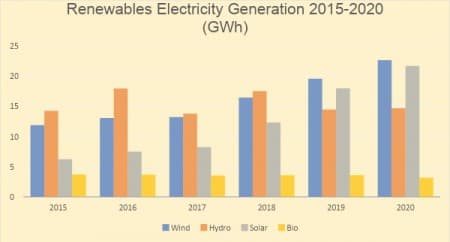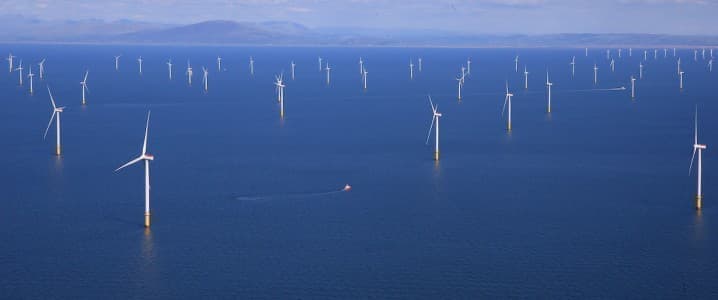It is very hard to give up on one’s own resource bounty and Australia knows it only too well. Endowed with the world’s third-largest coal reserves coupled with ample hydrocarbon plays in offshore deposits, many of which are still yet to be assessed and located, Australia’s energy transition to include more of renewables into its energy matrix has always been burdened by cautious skepticism. Would it serve Australia’s interests if it started to wind down coal production too soon? Difficult as it is to answer that question reliably, Australia would certainly benefit from a bit of experimenting, incorporating the lowest-hanging renewables fruits and then seeing where to go next. Bursting into the public consciousness with grand ambitious projects, wind energy might very well become Australia’s new favourite. Of the 260GW renewable energy capacity added in 2020 across the globe, Australia’s share corresponded to 3% (7GW). This was marked as an unprecedented result by the Australian authorities and rightly so, the tangible increase in rooftop solar installations during the past two years has significantly boosted the country’s renewables statistics (see Graph 1). COVID, several lockdowns and decreasing solar subsidies notwithstanding, Australia managed to reach its installed renewables capacity target of 33GW. At the same time, given Australia’s massive potential, wielding a total installed capacity of 35.7GW for all categories of renewable energy – i.e. including hydro energy which barely moved in the last decade – feels as if there remains significant underutilized capacity.
Related: Offshore Wind To See Spending Explode To $810 Billion This Decade
Graph 1. Australia’s Renewable Energy Capacity in 2011-2020 (in Gigawatts).

Source: IRENA. One of the most evident segments that has been missing heretofore but could provide a quick boost to Australia’s renewables potential is offshore wind. Wind energy as such has gradually become Australia’s most robust renewables segment in terms of aggregate generation (see Graph 2), largely thanks to its southern coastline lying within the Roaring Forties zone – the combination of vast swathes of open ocean and air being moved from the Equator towards the South Pole engenders winds powerful enough to keep the wind farms operating at 35-40% capacity. The state of South Australia leads the pack – almost 60% of its electricity generation is renewables-based (wind). This should not come as a surprise, considering that its entire coastline boasts average wind speeds of 9 meters/second and higher.
Graph 2. Renewables Electricity Generation in 2015-2020 (Gigawatthours).

Source: Department of Industry, Science, Energy and Resources; Clean Energy Council.
Robust as it remains, wind energy has heretofore had only one peculiarity – all of it was onshore (in total more than 100 wind farms). Whilst there should be no qualms about the strength and continuity of winds in Australia’s waters to the south of Victoria and South Australia, there still seem to be two main road blocks ahead for offshore wind - connecting the prospective wind farms into Australia’s grid system and erecting the legal framework underpinning offshore wind. Even the official website of Australia’s government admits that it still lacks „legislation to support the full development of offshore” projects – that is, provided the wind farm is not located within 3 nautical miles from the shore (then it is up to regional governments to decide). Canberra has been working on the offshore wind regulation for more than a year already. Related: China Snubs U.S. With Huge Iraqi Gas Deal

Source: Star of the South.
Lack of federal regulation notwithstanding, Star of the South was given a deed of licence and is thus good to go. Star of the South has already decided on its subsea transmission route, with the transmission line coming ashore next to Reeves Beach and then connecting into the grid of the National Electricity Market in Victoria. The operating company foresses 2 potential grid connection points, in Loy Yang and Hazelwood and it is the former that might be of considerable interest to Australia watchers. The 3.3GW Loy Yang power plant boasts the largest capacity in all of Australia, supplying roughly 50% of Victoria’s electricity needs. Needless to say Loy Yang is fuelled by brown coal from the Latrobe Valley, triggering the question whether the Australian authorities would seek to supplant or supplement it with electricity generated by Star of the South.
The future interaction between wind energy and coal projects in the Latrobe Valley, one of the largest reserve bases for brown coal globally (estimated to be as high as 65 billion metric tons), will be one of the most pertinent trends to watch. Australia’s public discourse is still yet to strike a consensual tone on the conditions of the energy transition, as many see the compelled moving away from coal as a badly disguised attempt to destroy domestic jobs. Australia does not have a strictly delineated national emissions-cutting target (the states stipulate their own targets), although the government has repeatedly claimed that it seeks to decrease emissions by 26-28% from their 2005 level.
Star of the South has triggered a new wave of interest in offshore wind projects in Australia. A UK firm called Australis Energy (purports to be focused on Australian wind opportunities) has submitted documents for environmental approval, with the aim of constructing a $1 billion wind farm with a total capacity of 0.3GW. This endeavor might turn out to be the first offshore wind farm along Australia’s western coastline, according to preliminary estimates it will amount to 20 turbines with a 15MW capacity each. Building smaller farms has its upsides, too, as Australis’ intention is to locate it in territorial seas requiring alignment only with regional authorities – in contrast Star of the South will be located in Australia’s EEZ and hence requires federal approval.
By Viktor Katona for Oilprice.com
More Top Reads From Oilprice.com:
- How Russia Could Kickstart Another Oil Price War
- EU Admits It Can’t Go Net-Zero Without Natural Gas
- The 5 Most Influential Oil Companies In The World


















